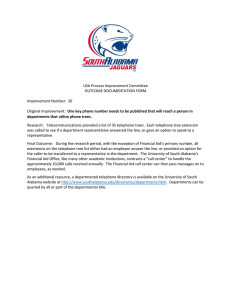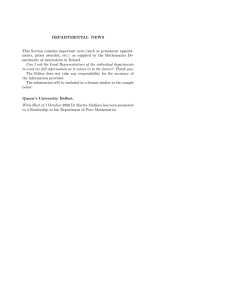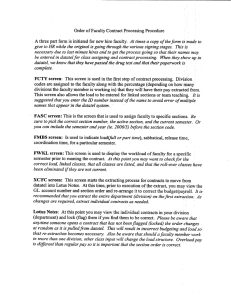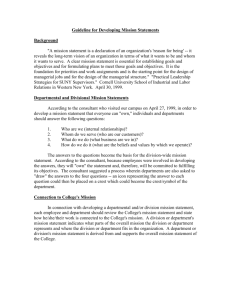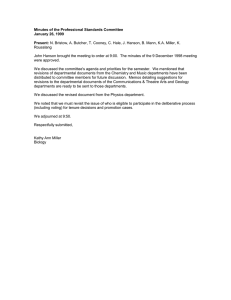REVIEW OF THE DEPARTMENT OF RADIOLOGY
advertisement
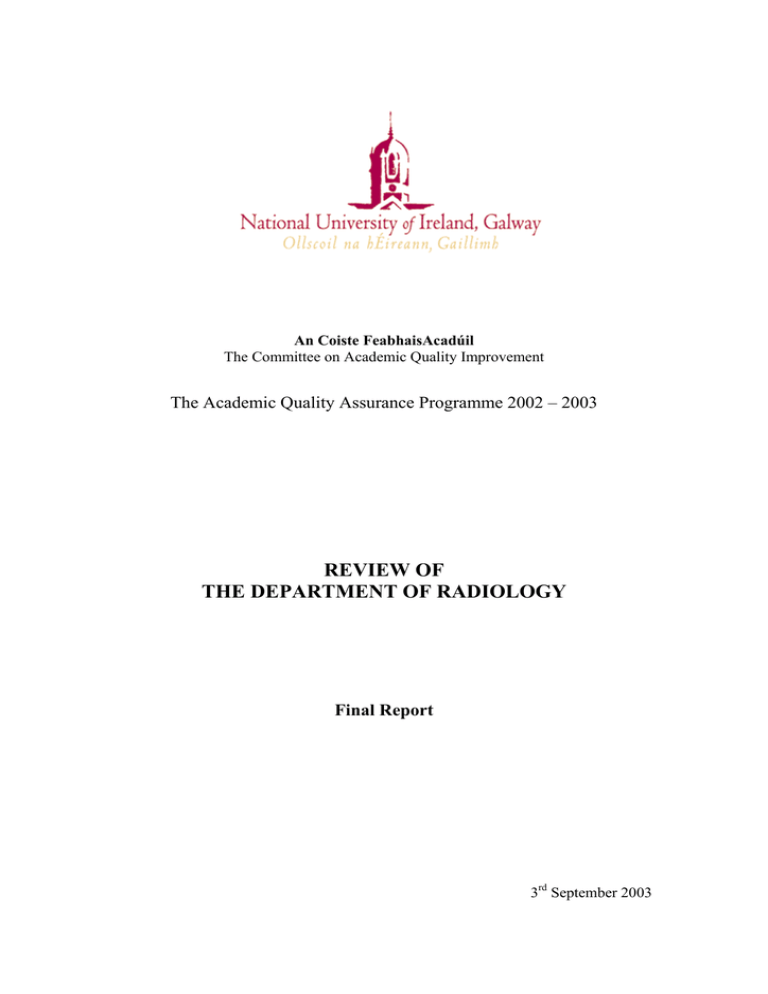
An Coiste FeabhaisAcadúil The Committee on Academic Quality Improvement The Academic Quality Assurance Programme 2002 – 2003 REVIEW OF THE DEPARTMENT OF RADIOLOGY Final Report 3rd September 2003 This report arises from a visit by a review team to the Department of Ophthalmology on the 11th-13th February, 2003. The Department had already prepared and submitted a 'Self Assessment Report' that, with other documentation, was made available to the review team well in advance of the visit. The review team consisted of: Professor Brian Kavanagh, Dept. of Critical Care Medicine, Hospital for Sick Children, Toronto (Chairperson); Professor Helen Carty, Department of Radiology, Royal Liverpool Children’s Hospital; Professor John Reynolds, Department of Surgery, St. James’s Hospital, Dublin and Dr. Geraldine Gaffney, Department of Obstetrics & Gynaecology, NUI, Galway; and Dr. Iain MacLabhrainn of the CFA acting as rapporteur. The report is structured to cover the following main topics 1. 2. 3. 4. 5. 6. 7. 1. Aims and Objectives Organization and management Programmes and Instruction Scholarship and Research Community Service & Wider Context Summary and Concluding Remarks Generic Issues Aims and Objectives The departmental aims are generic and laudable with respect to the Department’s role. The stated aims were not effectively operationalized at the time of the review, vis-à-vis research in particular. The aims were developed in 1991, and do not appear to have been updated since that time. 2. Organization and management The Department is organized along clinical lines, led by Professor & Head, Professor McCarthy. There is strong support for the Department Head among the consultant staff whom the panel met. There is a Departmental academic office, but no other infrastructural support in terms of space, provided by the university. The administrative support consists of a secretary (0.2 FTE), with a reliance on Health Board administrative staff. There is a serious and fundamental problem of contract between the Professor and the Faculty of Medicine & Health Sciences, which may be impacting on the department’s academic related activities and could be a limiting factor on future development. 3. Programmes and Instruction There is a traditional approach to teaching in the Department, with a high number of scheduled didactic lectures and tutorials. This is apparently also the norm across other courses in the Faculty. Curricular reform, in which the Faculty is currently engaged, should look at teaching methods, the use of a variety of resources and the potential development and use of self-study materials. A Faculty teaching and learning strategy should be considered with specific recommendations regarding student feedback (to ensure consistency and comparability) and support for staff to develop their teaching skills. 2 Teaching booklets containing relevant course materials, references, etc as produced by a number of departments in the Faculty were felt to be examples of good practice and their production should be encouraged across all departments. The teaching timetable requires clarification and adjustment to match assessment and attachments with the teaching blocks in a more satisfactory way and some attention needs to be paid to the fact that the lecture/teaching programme isn’t always able to be fulfilled given the inevitable tension between clinical and academic responsibilities. There is an evident need for an adequately equipped clinical skills laboratory that could be shared with the other small departments to ensure that the students have ample opportunity for self-study and supervised practical sessions outwith the busy health board accommodation. Strengths: 1. There is support and enthusiasm of staff and recognition of clinical excellence and teaching efforts from other departments, including sustained teaching in an overcrowded curriculum. 2. There has been a steady output of publications and presentations, as well as prizewinning students. 3. The library provision is very good. Weaknesses: 1. Communication between the department and the Faculty/University is poor; this is of concern regarding the development of the department. 2. There is a lack of formal mechanisms for student feedback, and insufficient suitable teaching equipment near the clinical areas. 3. There is inadequate secretarial support. 4. Some staff decline to participate in the teaching programme. Opportunities: 1. There is great potential to integrate radiology across the curriculum with other subject areas, and enthusiasm exists within the department for this. 2. In addition, significant potential exists for new course developments in nursing and other subject areas. Threats: 1. Lack of resolution of the contractual dispute between the professor and the university threatens the overall development of the department. 4. Scholarship and Research The Department has focused on clinical research in its output over the last four years, the areas being prostate cancer, renal imaging, mammography and the nephrotoxicity of water soluble contrast media. Professor McCarthy, Dr. O’Keefe and colleagues have presented and published work nationally and internationally on quite a consistent basis in the last decade; in this context, the previous understaffing (until recently) is noted by the reviewers. The research productivity has been of a case-report nature, and although there has been research activity, a defined departmental research strategy (or vision) does not exist. Postgraduate research programmes have consisted mostly of MMedSci degrees, supervised by Prof. McCarthy; however, no substantive peer-review grant income has been obtained. The focus has been on undergraduate research projects, a laudable initiative that has been adopted now by other Departments in Medicine and Health Sciences. This does not achieve published work but it does qualitatively enrich the academic environment. 3 The future input of the Department to teach undergraduates in the preclinical (e.g. Anatomy) and clinical years in a defined area of the curriculum may also offer further opportunities for research as well as developing the academic potential of the Department. The opportunity for a new era of research has been enabled by new appointments in the Department who have track records in research. The environment, particularly in relation to possible links with Biomedical Engineering, and the technology and pharmacology industry, creates enormous opportunity for academic growth. Importantly, the critical mass of the consultant complement now offers the opportunity to develop a research strategy. The dispute between Prof. McCarthy and the university in relation to his contractual terms may be a significant barrier to the development of a research strategy and this must be immediately resolved. 5. Community Service & the Wider Context The Head of Department has served on university committees and was Vice-Dean of the Medical Faculty from 1994-1998. In addition he has served as a Member of the Health Research Board, whilst another staff member is a member of the IHCA executive. 6. Summary and Concluding Remarks The department of radiology has had recent clinical expansion and new members of the department show support for Professor McCarthy. The contractual arrangements between Professor McCarthy and the University requires urgent clarification as this may have hindered developments within the department, in particular in the development of research activities, although there is a steady output of papers and presentations. Professor McCarthy’s contribution to developing undergraduate research interests through the HRB Summer Student Scheme and organisation of the annual research day is to be commended. The participation of the department in the undergraduate course requires formal assessment and provision should be made for radiology to participate in teaching within a vertically integrated undergraduate course. Greater encouragement and support should be given to the clinical members of staff to develop research activity and to fostering links between other departments within the Faculty and within the University. The following is a summary of the key findings of the review panel relating to this department. 1. Professorial Contract There is a serious dispute regarding the contract between the professor and the faculty/university. 2. Excellent Clinical Department The department is a well respected clinical department, and is close to achieving optimal staffing levels. However, assessment of clinical issues was not the purpose of the current review. There is good ‘esprit de corps’ among the consultant staff that the review panel met. 3. Undergraduate Education The teaching during the undergraduate 1 week attachment was rated as good. There is no formal curriculum block that is assessed or provides linkage to University support (i.e. relationship between FTE vs. budget). There is insufficient teaching space 4 4. Research Reasonable publication output and excellent record in promoting undergraduate research, however there is no research strategy. There are excellent current and future opportunities for interdisciplinary research (e.g. radiation therapy, biomedical science) 5. Organization and Support There is minimal administrative support, and the organisational arrangement within the Faculty management structures is unclear. 7. Generic issues pertaining to Departments reviewed during this visit. Throughout the review process, several ‘generic’ issues became apparent to the review panel, who were responsible for reviewing the Departments of Otorhinolaryngology, Anaesthesia and Radiology and Ophthalomology. 1. Full-time Dean. The Dean of the Faculty is a part-time position. The external members of the panel believe that a full-time Dean is required at NUI (Galway), and indeed this common need in all Irish Universities at this time is widely recognised. 2. Departmental Budgets The system of linking departmental credit and budget to the curriculum-linked student FTE is inappropriate for rewarding departments that are unable to achieve representation in the final medical examination. It may discriminate against such departments, and provide unfair advantage to departments whose curriculum is in part taught by ‘noncredited’ departments. 3. Curriculum Review Committee The structure of the curriculum review committee is small and does not represent many departments (e.g. anaesthesia, radiology) that are not featured as distinct elements in the traditional curriculum. This is inappropriate, and reflects (apart from medical informatics) a binding of undergraduate teaching to a traditional medical degree construct (Bachelor of Medicine, Bachelor of Surgery, etc). 4. Faculty Research Strategy All departments should be welcomed as members of the faculty research committee 5. Skills Teaching and Facilities The teaching facilities that we visited were uniformly archaic; the space and facilities for teaching need to be developed along modern lines. There are particular opportunities for all Departments involved in this review process and this theme should be driven through cross-Departmental strategy within the Faculty and curriculum review group. 6. Communication, Transparency, & Concordance in Perceptions The panel was struck by some discordance in perspective as portrayed by the Dean compared with that portrayed by some of the consultant staff. 7. Student Numbers The panel was concerned that the plans for increased student enrolment were not accompanied by adequately developed plans for teaching space and resources 8. Academic Contracts There were serious staff contract issues in two of the four departments reviewed. 5 9. Stipend for Clinical Lecturers - potential for creative development An approach to financial issues, suggested by Dr Flynn (Anaesthesia), was that departmental clinical lecturers’ stipends be pooled and directed to the departments for academic purposes. The panel viewed this as imaginative and creative. 10. Training the Teachers The consultant staff need to be offered, and to engage in, formal processes designed to learn and maintain teaching skills. 11. Academic Promotion The consultant staff need to be offered a process of academic promotion for teaching and or research, based on validated and accepted criteria. There is no incentive (aside from a stipend that is essentially negligible relative to overall income) for consultants to teach medical students, and from what the panel can discern, many consultants do not teach. 6 Comments on the Methodology of the Review Process 1. Staff from the departments and the Quality Office were considerate and efficient. 2. By and large, the documentation submitted was good, well structured and clear. 3. It was felt by the review group that the number of departments under consideration on this single visit was too large and future reviews of these units should be organized differently. 4. It was felt that the absence of input from the Department of Surgery provided the review group with a number of difficulties. Furthermore, the rationale presented that a review was inappropriate in the absence of a Head of Department was not an opinion shared by the review group, insofar as a review may be a critical source of information for a new appointment. 5. Given the number of departments and the amount of documentation required, the group would have benefited from a dedicated administrative assistant. 6. The lack of adequate modern facilities for the review group was also problematic and the provision of networked computer access, printer, telephone etc, would have aided the process. Professor B. Kavanagh (Chair) Professor H. Carty Professor J. Reynolds Dr. G. Gaffney Dr I. Mac Labhrainn (Rapporteur) (3rd September 2003) 7
